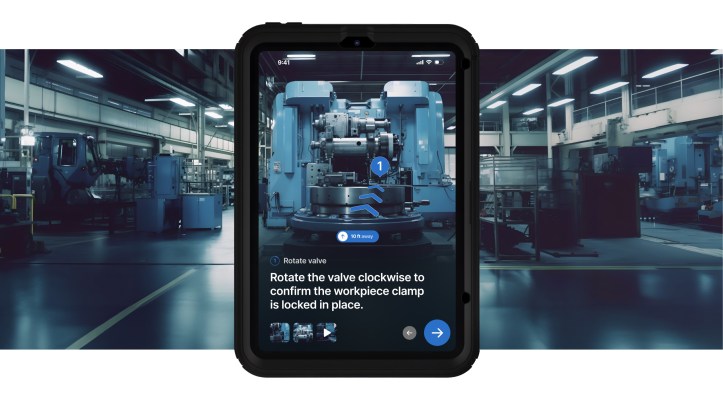Apple’s and Google’s move into smart augmented reality several years ago, creating ways for people to use their smartphone cameras to identify everyday objects to interact with them, put the technology on the map with everyday consumers and gave a way for businesses to build new experiences to cater to them. It also laid the groundwork for building new frontiers in visual search.
Squint is one of the startups capitalizing on this concept with what founder and CEO Devin Bhushan describes as “a platform that connects people with the right information at the right time.”
Focusing for now on business users, it has created a simple and fast way for organizations to build AR-based workflows: users pointing their smartphone or tablet cameras at physical objects in the work environment — whether or not those objects are “smart” and connected or not — can trigger detailed, step-by-step instructions to use those machines, log sheets to record maintenance or other work and more, and they can use generative AI-based interactions to even figure out what they need to know.
Squint to date has picked up a number of large enterprise customers who use it to manage workflows in factories and other industrial settings, including Volvo, Siemens, Colgate-Palmolive, Michelin and Berkshire Hathaway Energy. Now, to fuel its business growth and more tech development, Squint is announcing a Series A of $13 million led by Sequoia, with participation from Menlo Ventures.
B2B is its initial target, but contrary to its name, Squint has a wider focus. Its ultimate goal, Bhushan said, is to “eliminate the search bar, and eliminate all that time we spend looking for information and data.”
Bhushan first came up with the concept for the company when he was working in a very different kind of business: He was an engineering manager at Splunk, where he helped conceive of and build Splunk AR, a way for users of the data analytics company’s tools to map that data directly on to physical machines to better understand how they were working in real time.
The idea was to widen out Splunk’s addressable customer base to more non-technical users.
“People actually really loved it, but they didn’t have that many use cases for just visualizing Splunk data,” he recalled. However, he was seeing that customers were trying to use the AR tool for other kinds of workflows, which are outside of what Splunk handled on the data side, and that got Bhushan’s enterprise antennae twitching. “We’re on to something with this concept,” he said he thought to himself. “I think we can actually bring AR to the masses. There’s been an unlock.”
Bhushan left Splunk in 2021 to pursue this idea with the founding of Squint. He said that while working at Splunk got him thinking about the bigger problem, Squint’s objectives, and route to achieving them, is very distinct.
“At Splunk we never solved the problem around allowing data and information from anywhere to come in and we also never solved the authoring problem (since it would just let you scan your device and see metrics),” he said. “At Squint we innovated around the object detection portion and also on the content creation.” For example, computer vision and object detection are used to turn videos into AR procedures, he added.
“We also wrote it entirely from scratch, more using our time at Splunk as a learning experience.”
There are a number of ways already in the market to provide help to those working in industrial or other hands-on roles. If a business already equips workers with handsets or tablets, they may have apps pre-loaded on them, or they might stick QR codes on the machines themselves. The more common approach has been very analogue: manuals with instructions and registration logs when people have to verify their work.
The advantage to Squint’s solution, Bhushan said, is that it’s more dynamic and specific: A business can create workflows easily and tie them to very specific actions to be carried out by users, and to specific areas of a machine’s system. The AI in the system covers not just the computer vision for recognizing objects, but around the workflows that a person might be going through and the generative AI that powers the ability to ask questions and get answers from the platform.
Bhushan’s first stop as founder was to do a stint incubating the company at Menlo Ventures, as part of its Menlo Labs product: His connect was Tim Tully, a partner at the firm who had been the CTO of Splunk and worked closely with Bhushan there.
Squint in turn became acquainted with the Sequoia team when it was in a cohort of Arc, Sequoia VC’s early-stage program for finding and mentoring outlier startups. (Menlo and Sequoia are both previous investors as a result.)
But Bhushan goes back even further with Jess Lee, the Sequoia partner who helps run Arc: The two were at Yahoo together almost a decade ago. She described the first time she saw Devin demonstrate how Squint worked as a “moment of intuitive magic,” similar to what she said she felt the first time she saw an AirTag, she said.
Lee believes that the time is ripe for building the next generation of tools to help skilled laborers do their work better. “When you are put on a new job, you can find the person on the floor who can talk you through what to do, or you can go to a storage room to find a binder, or you can wing it. Or, you can take out your phone and that can help you figure it out,” she said.
Whether it’s for taking stock, machine maintenance or something else, the key is that Squint signals how tech will ultimately penetrate into the offline world beyond knowledge workers. In these situations, “no one thinks about whether they are using AI or AR,” she added.
